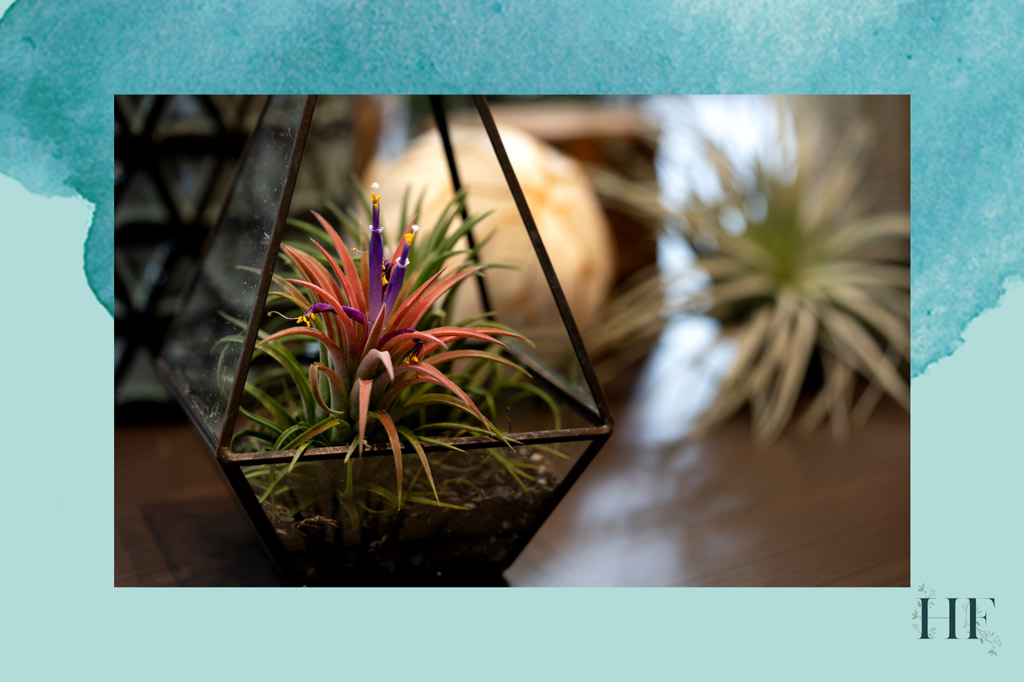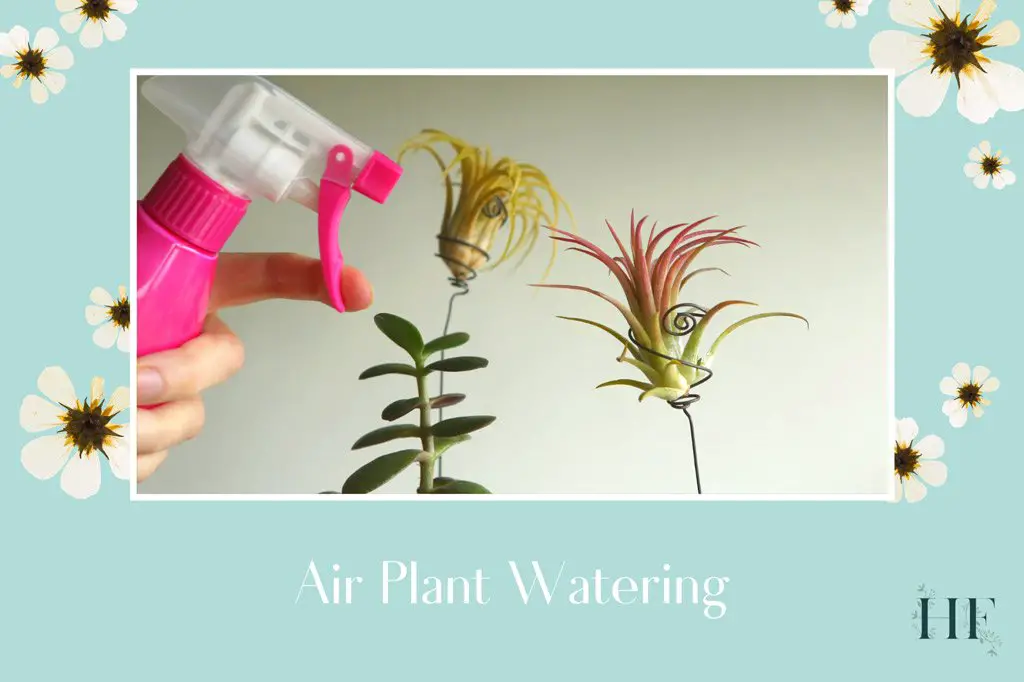Since Tillandsias are different from your other houseplants, air plant watering also differs. So how do you water air plants and how often?
Air plants need to be watered once a week by soaking them (fully submerged) in a bowl of water for 20 minutes to 1 hour. Misting air plants once a week is helpful but is not a substitute for soaking.
How you water your air plant and the type of water you use matters. Plus the Tillandsia species that you are watering also has a say!
Air Plant Water Needs
There are 3 factors for healthy, reproducing air plants: water, light and nutrients.
Do Air Plants Need Water?
It’s a myth that air plants can live on air alone – it definitely is not the case.
Their common name comes from the fact that the Tillandsia genus doesn’t require soil to live. Instead, air plants need water to live; they absorb moisture and nutrients from the air through the trichomes on their leaves, rather than through their roots.
The leaves of Tillandsia have a vascular system that acts to transport nutrients and moisture throughout the plant.
That being said…
How Much Water Do Air Plants Need?
The natural habitat of Tillandsias shows that these plants thrive in warm and humid conditions. Air plants have evolved from two distinct climate groups: mesic and xeric.
The mesic type of air plants prefers moderate humidity and frequent watering. Xeric types, however, thrive in a drier climate with high humidity levels and require less watering.
Mesic Tillandsias are used to regular the rain, fog, and mist of tropical rainforests. Xeric Tillandsias grow exposed to the sun in desserts and cliffs.
Indoors, as houseplants, how much water air plants need depends on the environment they are growing in. Factors like light, temperature, airflow and humidity will influence how much to water an air plant.
Read also: Air Plant Environment – Light, Temperature, and Humidity Needs.
What Type of Water Do Air Plants Need?
In their natural habitat, air plants get their nutrients from rainwater, bird droppings, and dying bugs.
Tap water is very different from rainwater due to the mineral contents and purification systems that add fluoride or/and chlorine to it.
The best type of water to water air plants is rainwater since it’s richer in natural minerals and nutrients that are beneficial to air plants. Also, use lukewarm water because cold or hot water will shock the plant.
If you have a garden or space for it, you could collect rainwater in a tank. Otherwise, you can use:
- Springwater.
- Filtered water – beware of the levels of salt that can build up in the plant leaves.
- Tap water – allow it to sit at room temperature for 24 hours for the chlorine to dissipate.
“Avoid using tap water especially in hard water areas as the water contains dissolved sodium bicarbonate which can precipitate out on the trichomes and block them, preventing the Tillandsia from absorbing moisture and nutrients.”
The Royal Horticultural Society (RHS) in the U.K.
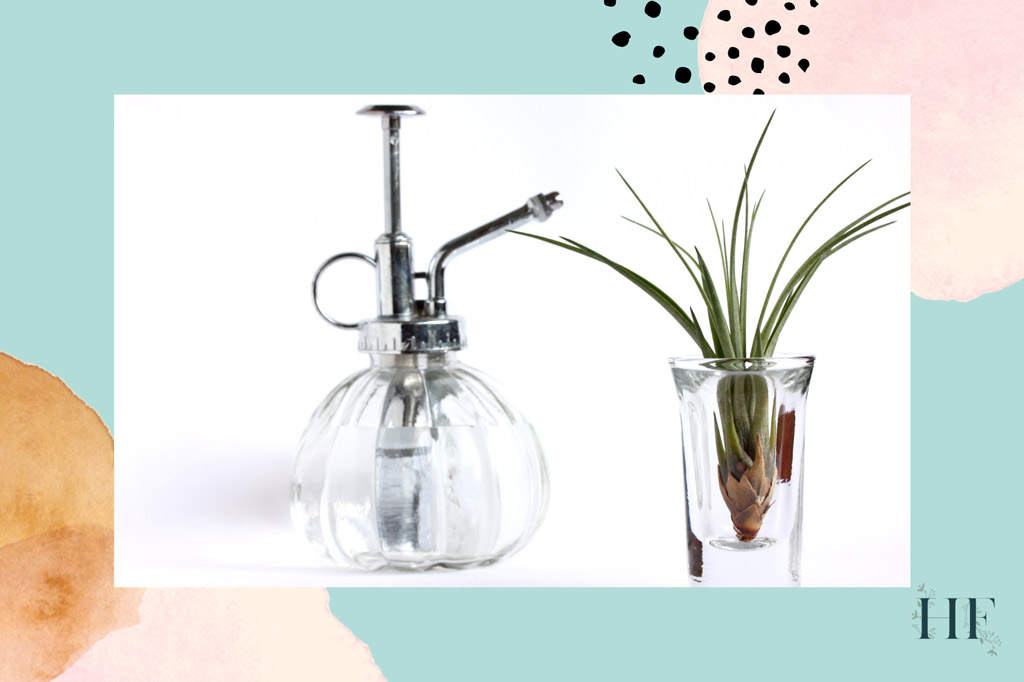
Air Plant Watering Schedule
The first step of proper air plant care is to ensure the leaves receive the right amount of moisture.
How Often Do You Water an Air Plant?
Each air plant variety is different and will require an individual watering schedule. Why?
When and how often you water air plants will depend on 5 factors:
- Climate group (mesic or xeric).
- Local climate (dry, humid, etc.).
- Seasonality (spring, summer, autumn or winter).
- Environment (light, air, temperature and humidity).
- Display (glass terrarium, mounted, hanging, etc.).
As a general guideline, water your air plants once a week. If the air in your house is particularly dry, water your air plant more often (every five days). In a humid environment, water it every ten days.
You can also mist your plants as needed in between watering, but misting should not be used as a sole source of moisture in most cases. I always prefer to use a glass mister instead of a plastic one.
Insider Tip: Allowing air plants to dry off in between waterings is very important for the health of your Tillandsia.
Seasonal Watering for Air Plants
If there’s a difference between seasons where you live, then you should adjust your air plant watering schedule accordingly.
Insider Tip: Do all the watering in the morning. You might be wondering why… that’s because if you soak or mist an air plant in the evening, it disrupts the plant’s ability to respire overnight and also extends its drying time.
I water my houseplants (or check if they need water, to be precise) on Sunday mornings and mist some of them on Wednesdays (depending on how dry the air is).
Watering an Air Plant in Summer
In the summer, when it is hot, air plants should be soaked once a week on average.
In higher temperatures but low humidity, watering may be required more frequently; less often in cooler, humid conditions.
Insider Tip: Air plants that are constantly being dried out from A/C or heaters will require more moisture than a plant that is located in a more humid environment like a kitchen or a bathroom.
Watering an Air Plant in Winter
In the cool winter months, you should reduce the watering frequency to once every three weeks or so.
Also, avoid watering the plants if temperatures drop to 12ºC (54ºF) as they can remain wet for too long.
However, pay attention to the humidity levels too. Your home will be drier if the heating or the fireplace is on. You might need to mist them if they look dry.
Read also: Air Plant Care – 8 Steps to Grow and Keep Tillandsias Alive.
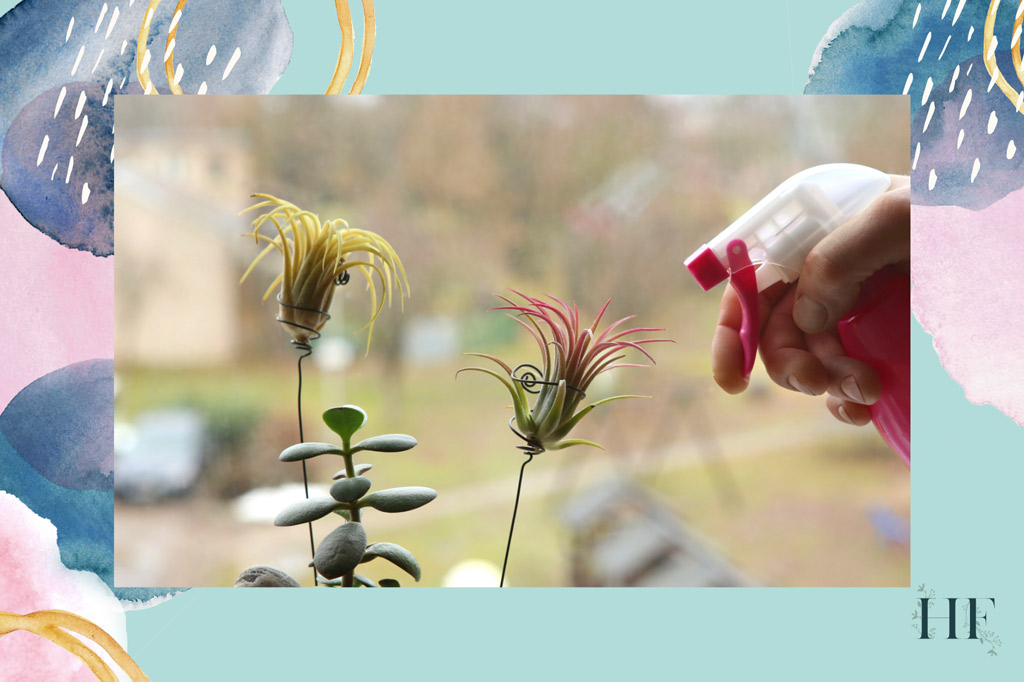
How Do You Know If Air Plants Need Water?
After watering, the leaves of an air plant will feel stiffer and full of water. However, these leaves will appear softer and lighter in colour when the plant is in need of water.
When do air plants need water?
Signs of under-watering (dehydration) in air plants include:
- Curling, wrinkling or rolling leaves.
- Leaf tips turning brown, dry or crispy.
- Leaves are lighter in colour.
These are signs that your air plant needs to be watered more frequently. Remember that the mesic type needs to be watered more frequently than the xeric type.
How Long Can Air Plants Go Without Water?
While air plants can survive for long periods of drought, they will not grow or thrive, and they will eventually die if the water is too scarce.
If you are going on vacation for 2 weeks, you should soak them in water for 12 hours before you go and then do the same upon your return.
Alternatively, if you have a garden, you can place them in all day shady area and set up an automatic water sprinkler system that can water your air plants (and other plants) twice a week. Here’s a garden hose timer programmable that does the job, plus you can control it for an app!
Can You Overwater an Air Plant?
You can underwater but also overwater air plants. If air plants are not allowed to dry after being watered (the water will concentrate in the crown of the plant), signs of rot will start appearing.
Signs of overwatering (rotting) in air plants include:
- Black or brown colouring at the base or centre of the plant.
- Leaves falling off from the centre.
That’s how you can tell if you overwatered your air plant.
Unfortunately, if your Tillandsia has been over-watered, it’s often too late to save it.
Read also: 13 Common Air Plant Problems, Pests and Diseases – to keep an eye on signs that indicate overwatering, underwatering and other problems.
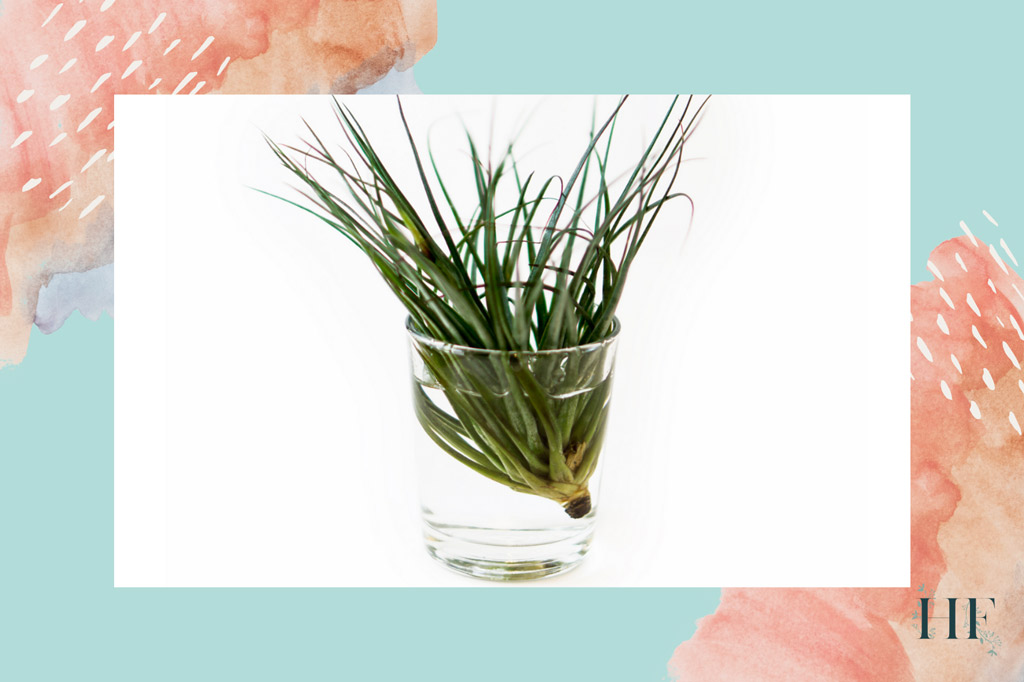
How to Water Air Plants
There are three ways to water air plants:
- Soaking.
- Dunking.
- Misting.
Let’s get into the details!
Soaking Method
Here’s how to water air plants, using the soaking method, step by step:
- Fill a basin, bowl, or sink with lukewarm water (rainwater is preferable because it’s high in minerals).
- Dunk your air plants in the water and make sure that they are fully submerged.
- If your air plant is blooming, refer to the How to Water a Blooming Air Plant section below.
- Leave them soaking for 20 minutes to an hour.
- Remove your Tillandsias from the water, after that time has passed.
- Then, gently shake the excess water from your plants.
- Next, tip them upside down as well, so any excess water can drain away.
- Be particularly careful with bulbous Tillandsias (they have a pseudobulb shape at their base) because if they get waterlogged, they will rot.
- Once there’s no excess water, spread them on a towel or kitchen roll to dry. Lay them out on their side so the water drains out of the centre (preventing rot).
- When choosing a spot to dry your plants, make sure the plants are kept away from:
- Direct sunlight.
- Extreme heat (ex. stove, heater, etc.).
- Frost (ex. near the windowsill when it’s below 50ºF outside).
- Let them dry for 4 hours before putting them back on display.
- It can take from 1 hour to 4 hours depending on the environmental conditions.
- Try placing them in a brighter place with more air circulation to facilitate faster drying.
- When the centre of the air plants feels dry to the touch, you can put them back in their display location. An air plant must dry out completely after soaking to prevent waterlogging and rotting.
Insider Tip: Use lukewarm water for soaking your air plants. The warm temperature will provide a gentle bath for the air plants to revive. Try to maintain a temperature between 18º to 24ºC (65º to 75ºF).
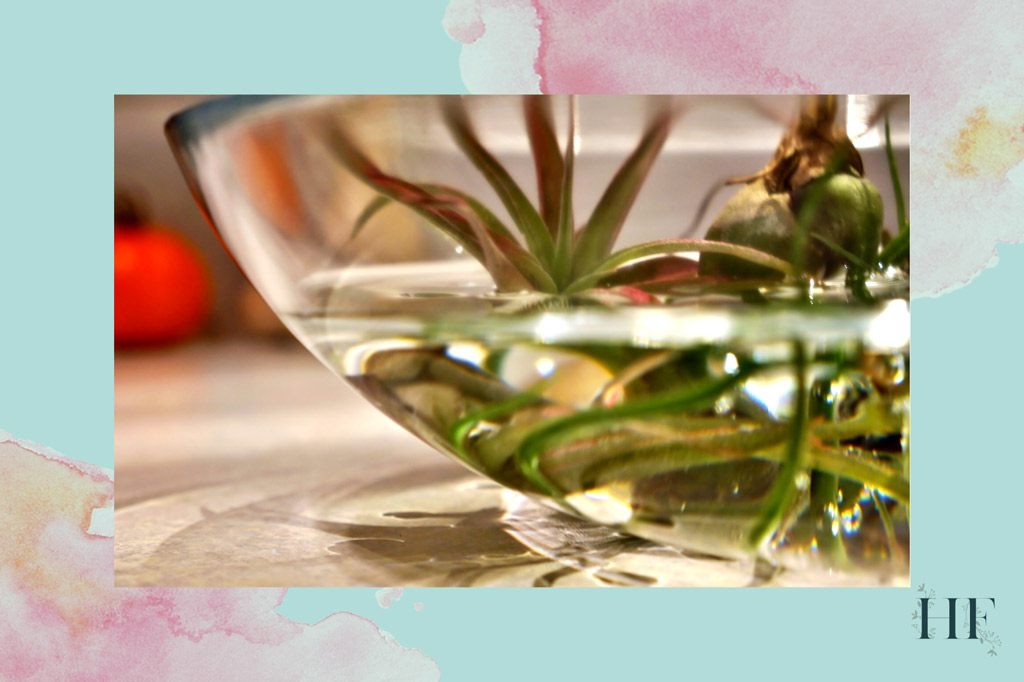
Dunking Method
Alternatively to soaking, you can also water your plants using the dunking method.
This method consists of dunking an air plant several times (2 to 4 times) in water or putting it under a running faucet. Afterwards, gently shake off any excess.
It is a practical method for:
- Mounted air plants: These are plants that are attached to wood.
- Dense or very curly leaved air plants: These plants are hard to mist thoroughly.
Dunk 2 to 4 times per week for mesic types and once a week for xeric types.
Misting Method
Misting air plants once a week is helpful but is no substitute for soaking since on its own does not provide sufficient moisture.
Insider Tip: Misting plants in-between soaks prevents dehydration in warm conditions.
Here’s how to water air plants, using the misting method, step by step:
- Fill an air plant mister or spray bottle with lukewarm water to avoid shocking your Tillandsias (and preferably rainwater).
- Take your air plant away from its display and place it on the sink surface.
- Mist your plants, avoiding the bloom.
- Spray so that the entire surface of the plant is moistened (but not so much that there is water dripping down into the plant). Remember that this is a light watering method.
- Gently shake off the excess water.
- Let your air plant dry (same as when soaking them).
- Once they are dry, place them back into their decorative container or arrangement.
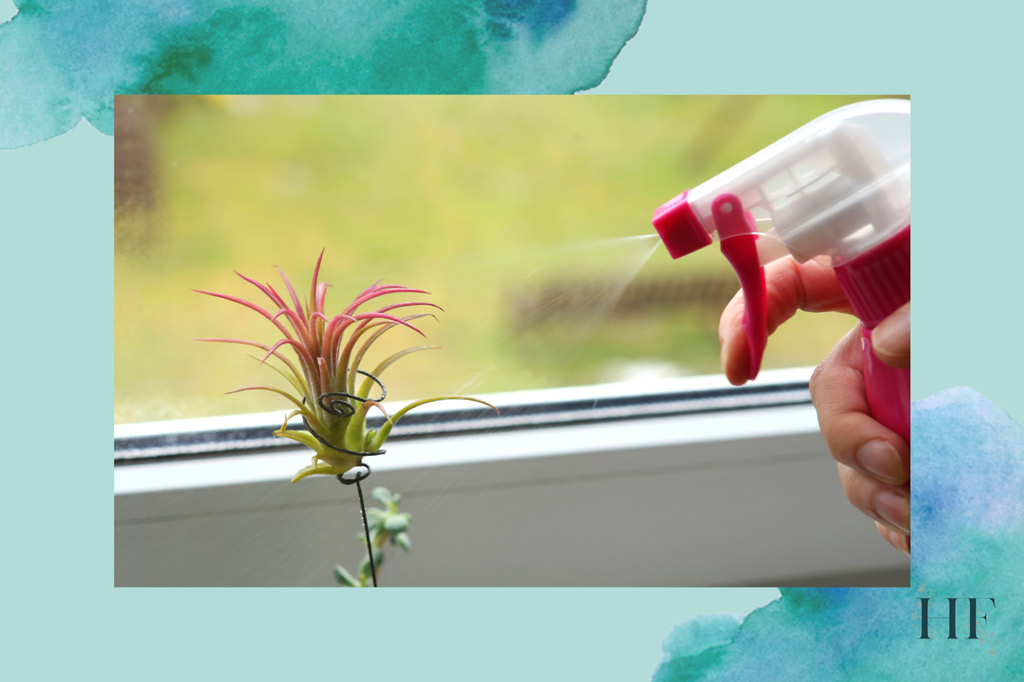
How to Water Air Plants in Terrariums
If you have your air plant in a glass container like a terrarium or an aerium for air plants, you need to take the Tillandsia plant out of the globe to water it.
Remember to allow the air plant to fully dry before returning it to its decorative setting. This usually can take up to 4 hours.
Glass containers (terrariums, globes, aeriums) will create a micro-climate: these containers will be more humid and hotter than the surrounding area. Glass intensifies the rays of the sun and the small opening will restrict air circulation.
- Small glass container: It has less air circulation, so the air plant requires a longer drying time and less frequent misting (once a week).
- Large glass container: There is more air circulation, so the air plant needs a shorter drying time and more frequent misting (twice a week).
Although you could mist an air plant inside the globe, I prefer to take the air plant out when watering, even for misting. It gives me better control with drying the plant and avoiding overwatering problems like rotting.
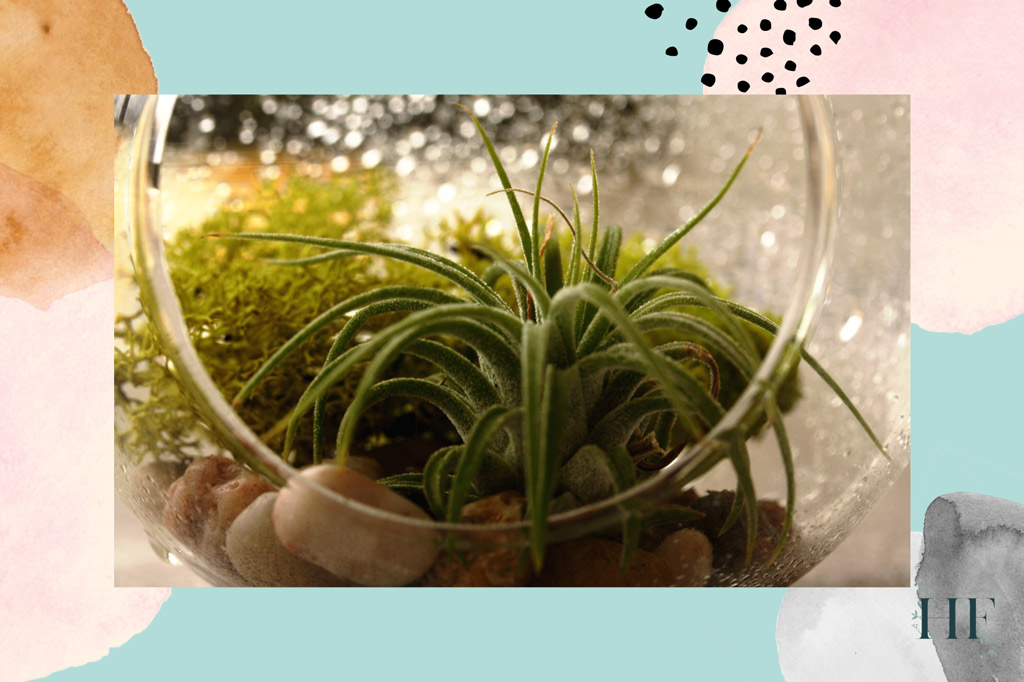
How to Water Mounted Air Plants
You probably won’t be able to soak your mounted air plant. Since they are not contained in a humid, micro-climate like glass globes, mounted air plants will need even more frequent misting.
When misting, angle your air plant facing downwards. Then, allow water to drain out of the centre of the plant. You can gently shake it after watering to dislodge any water droplets.
You can start by misting your mounted air plant twice a week and adjusting as necessary depending on how long it takes your Tillandsia to dry in your environment.
P.S. Dunking is also a good option for water mounted air plants.
Read also: 10 Air Plant Display Ideas that Won’t Harm Tillandsias.
How to Water a Blooming Air Plant
As expected, a blooming air plant will need a little more water than usual. This is because the plant is focusing all its energy on the flowers and the production of offsets or pups.
Insider Tip: To lengthen the life of the air plant bloom, try to keep the flower dry when watering. i.e., don’t get water into the flower. If you do, the flower will drop off.
Since having the flower soaked in water will cause it to wilt or rot, instead of soaking up your air plant while it’s blooming, you can:
- Option A: Mist your air plant using a spray bottle or mister.
- Option B: Hold the blooming air plant under running lukewarm water to wet only the leaves.
Read also: Air Plant Life Cycle, Reproduction and Growth Rate.
